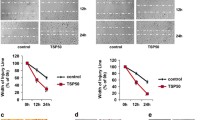Abstract
Testes-specific protease 50 (TSP50) has threonine activity and has homology to serine proteases. TSP50 protein, which is encoded by a possible proto-oncogene, is overexpressed in cervical tumor tissues. Through overexpression experiments using both TSP50 and a TSP50 mutant (TSP50 T310A), it is clear that this protein may play an important role in carcinogenesis and progression of cervical tumor. However, the mechanism underlying how TSP50 modulates cancer cell growth is still unclear. To examine the difference in TSP50 expression in cervical carcinoma tissues and in paracarcinoma tissues, we detected TSP50 mRNA and protein in ten paired tissues from patients with cervical cancer. To determine whether TSP50’s threonine protease activity is crucial for its effects on tumor formation, we generated a mutant version of TSP50 (T310A). Via overexpression and silencing experiments, we identified a role for TSP50 in cell proliferation and migration. Furthermore, we examined the signaling pathway of TNF-α-induced NFκB activation to explain the mechanism by which TSP50 participates in tumorigenesis. Similarly, we found that all these effects could be abolished by the TSP50 T310A mutation. Our results suggest that the threonine 310 residue within TSP50 helps modulate its role in cervical tumorigenesis and indicates that TSP50’s role in tumorigenesis may be dependent on its interaction with TNF-α-induced NF-κB.




Similar content being viewed by others
References
Song, Z. B., Bao, Y. L., Zhang, Y., et al. (2011). Testes-specific protease 50 (TSP50) promotes cell proliferation through the activation of the nuclear factor κB (NF-κB) signalling pathway. Biochemical Journal, 436, 457–467.
Shan, J., Yuan, L., Xiao, Q., et al. (2002). A possible protease in human testes, is activated in breast cancer epithelial cells. Cancer Research, 62, 290–294.
Xu, H., Shan, J., Jurukovski, V., et al. (2007). TSP50 encodes a testis-specific protease and is negatively regulated by p53. Cancer Research, 67, 1239–1245.
Li, Y. Y., Bao, Y. L., Song, Z. B., et al. (2012). The threonine protease activity of testes-specific protease 50 (TSP50) is essential for its function in cell proliferation. PLoS One, 7, e35030.
Xu, H. P., Yuan, L., Shan, J., et al. (2004). Localization and expression of TSP50 protein in human and rodent testes. Urology, 64, 826–832.
Zheng, L., Xie, G., Duan, G., et al. (2011). High expression of testes-specific protease 50 is associated with poor prognosis in colorectal carcinoma. PLoS One, 6, e22203.
Zhou, L., Bao, Y. L., Zhang, Y., et al. (2010). Knockdown of TSP50 inhibits cell proliferation and induces apoptosis in P19 cells. IUBMB Life, 62, 825–832.
Ghosh, S., Karin, M. (2002). Missing pieces in the NF-kappaB puzzle. Cell 109.
Lin, W. W., & Karin, M. A. (2007). Cytokine-mediated link between innate immunity, inflammation, and cancer. Journal of Clinical Investigation, 117, 1175–1183.
Mayo, M. W., & Baldwin, A. S. (2000). The transcription factor NF-kappaB: Control of oncogenesis and cancer therapy resistance. Biochimica et Biophysica Acta, 1470, M55–M62.
Nguyen, H., Sankaran, S., & Dandekar, S. (2006). Hepatitis C virus core protein induces expression of genes regulating immune evasion and anti-apoptosis in hepatocytes. Virology, 354, 58–68.
Lovas, A., Weidemann, A., Albrecht, D., Wiechert, L., et al. (2012). p100 Deficiency is insufficient for full activation of the alternative NF-κB pathway: TNF cooperates with p52-RelB in target gene transcription. PLoS One, 7, e427412012.
Ashikawa, K., Majumdar, S., Banerjee, S., et al. (2002). Piceatannol inhibits TNF-induced NF-κB activation and NF-κB-mediated gene expression through suppression of IκBα kinase and p65 phosphorylation. Journal of Immunology, 169, 6490–6497.
Nelsen, B., Hellman, L., & Sen, R. (1988). The NF-κB-binding site mediates phorbol ester-inducible transcription in nonlymphoid cells. Molecular and Cellular Biology, 8, 3526–3531.
Osborn, L., Kunkel, S., & Nabel, G. J. (1989). Tumor necrosis factor α and interleukin 1 stimulate the human immunodeficiency virus enhancer by activation of the nuclear factor κB. Proceedings of the National Academy of Sciences of the United States of America, 86, 2336–2340.
Schreck, R., Rieber, P., & Baeuerle, P. A. (1991). Reactive oxygen intermediates as apparently widely used messengers in the activation of the NF-κB transcription factor and HIV-1. EMBO Journal, 10, 2247–2258.
Yuan, L., Shan, J., De Risi, D., et al. (1999). Isolation of a novel gene, TSP50, by a hypomethylated DNA fragment in human breast cancer. Cancer Research, 59, 3215–3221.
Elavarasu, S., Sekar, S., & Murugan, T. (2012). Host modulation by therapeutic agents. Journal of Pharmacy and Bioallied Sciences, 4, S256–S259.
Al-Halabi, R., Bou Chedid, M., Abou Merhi, R., et al. (2011). Gallotannin inhibits NFκB signaling and growth of human colon cancer xenografts. Cancer Biology & Therapy, 12, 59–68.
Huang, G., Wen, Q., Zhao, Y., et al. (2013). NF-κB plays a key role in inducing CD274 expression in human monocytes after lipopolysaccharide treatment. PLoS One, 8, e61602.
Rhodus, N. L., Cheng, B., Myers, S., et al. (2005). The feasibility of monitoring NF-kappaB associated cytokines: TNF-alpha, IL-1alpha, IL-6, and IL-8 in whole saliva for the malignant transformation of oral lichen planus. Molecular Carcinogenesis, 44, 77–82.
Durowade, K. A., Osagbemi, G. K., Salaudeen, A. G., et al. (2012). Prevalence and risk factors of cervical cancer among women in an urban community of Kwara State, north central Nigeria. Journal of preventive medicine and hygiene, 53, 213–219.
Baldwin, A. S, Jr. (1996). The NF-κB and IκB proteins: New discoveries and insights. Annual Review of Immunology, 14, 649–683.
Acknowledgments
This work was supported by a Project Grant from the Natural Science Foundation of Heilongjiang Province (ZD201110). This research is supported by the Science and Technology Research Project of Heilongjiang Educational Committee (12541555).
Conflict of interest
There is no conflict of interest among the authors.
Author information
Authors and Affiliations
Corresponding author
Rights and permissions
About this article
Cite this article
Yuan, J., Wu, C., Huang, M. et al. TSP50 Depends on Its Threonine Protease Activity and Its Interactions with TNF-α-Induced NF-κB for Its Role in Human Cervical Tumorigenesis. Cell Biochem Biophys 71, 891–896 (2015). https://doi.org/10.1007/s12013-014-0279-8
Published:
Issue Date:
DOI: https://doi.org/10.1007/s12013-014-0279-8




